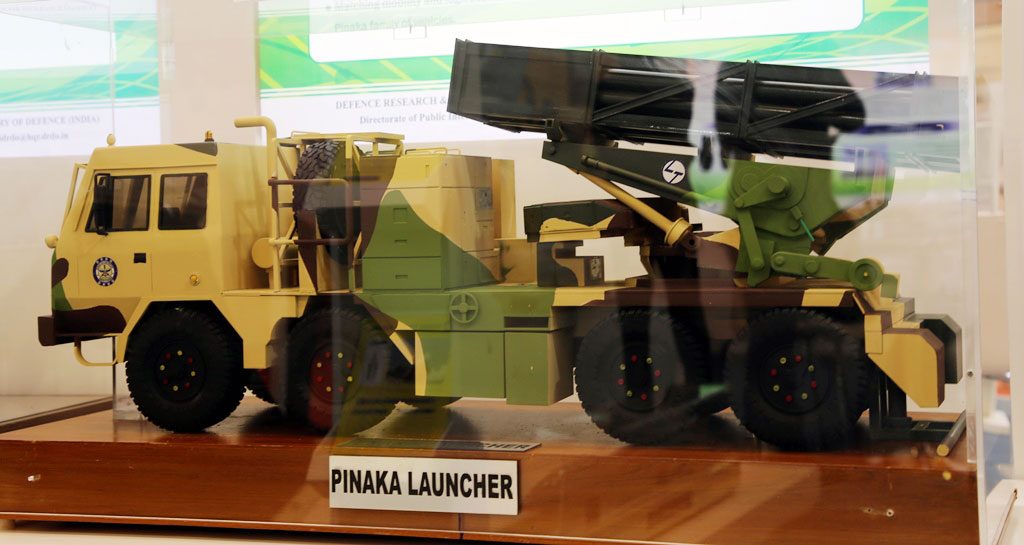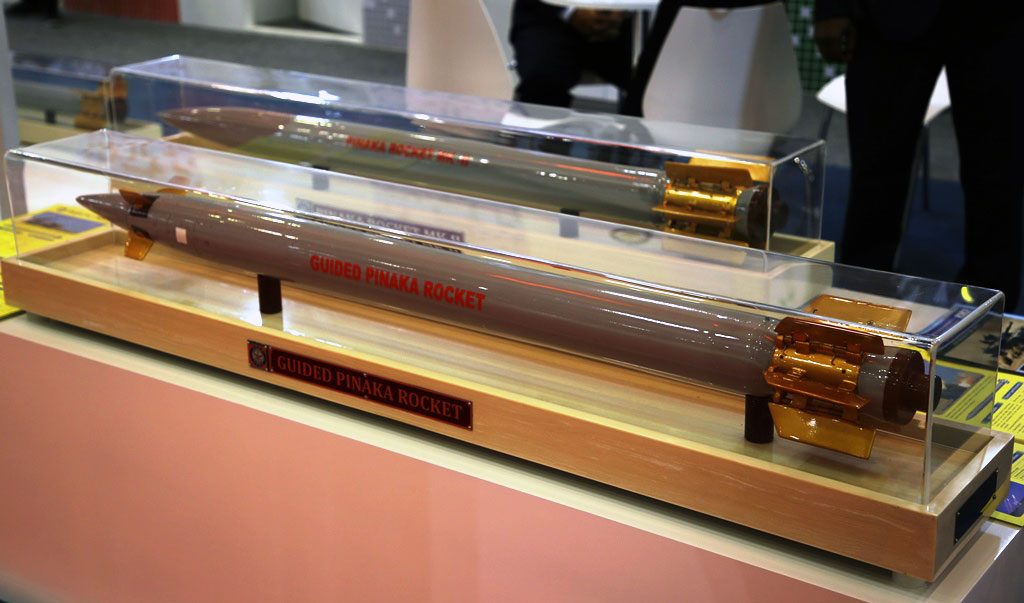
New rockets, missiles and armoured vehicles for India
The Indian Defence Research & Development Organisation exhibited at BIDEC, in model form, a number of weapon systems, some of them that have still to enter service in the national armed forces.
The Pinaka multiple rocket launcher is in service with India, however the system is evolving due to new rockets currently in their final stage of development. The Pinaka is fitted with a full command and control system and carries to six-rockets pods launching rockets of 214 mm calibre. The minimum range for the Pinaka Mk-I the rocket currently in service, is 12.6 km, the maximum one being 37.5 km The system, carried on an 8×8 truck, is ready for action within three minutes and leaves the firing location two minutes after the last rocket has been launched, the salvo of the 12 rockets taking 44 seconds. According to the DRDO a battery of six launchers can neutralise in 44 seconds an area of 1000 x 800 meters. The Mk-I rocket is 4,883 mm long and weighs 277 kg, 100 kg of which representing the warhead; the latter can be a PFF (Pre-Formed Fragment), submunition or Restricted HE, the latter for practice only. Accuracy is evaluated at 1.5% of the range.

The DRDO developed the Pinaka Mk-II rocket, which is longer, 5,175 mm, but can still be used in the same MRL. The Mk-II weighs 327 kg, the warhead remaining the same, the increased mass of propellant as well as the use of a propellant with a greater energy content, allowing to increase the maximum range at 60 km, the minimum range being increased at 16 km. The Mk-II is the basis from which the Guided Pinaka Rocket has been developed, fitted with a GPS and inertial navigation system, with a canard aerodynamic control kit installed at the front of the rocket. This version will be available only with the PFF warhead and will have a maximum range of 75 km, further increasing that of the Mk-II as the guidance kit provides it with some gliding capability that allows range increase. According to DRDO representatives, mass production of the Pinaka Mk-II and of the Guided Rocket will start in 2020, the former being an export ready product while the latter has undergone full demonstration and qualification.
The same will apply to the Nag antitank missile third generation system fitted with an infrared imaging seeker and a tandem hollow-charge warhead. A lock-on-before-launch missile, it can carry out top attacks hitting armoured vehicles in their weakest points. With a launch weight of 42 kg, it will be deployed on board a purposely developed missile carrier based on the BMP-2 chassis and carrying six ready-to-fire missiles, which optronic suite allows day/night operations. The missile is 1,720 mm long, has an operational range between 500 and 4,000 meters, its main hollow charge ensuring penetration of 808 mm RHA behind ERA, with a single kill probability of 0.8.

Another system which has still to be distributed to the troops is the WhAP 8×8, the acronym standing for Wheeled Armoured Platform that can be developed in different versions ranging from APC to Reconnaissance and Support, CBRN, Light tank, etc. In the amphibious version the GVW is 24 tonnes, however it is quite possible that giving up the floating capability the vehicle might increase its combat weight. The BMP-2 turret has been integrated on the vehicle, armed with the 30 mm cannon. No figures were provided on protection, however the vehicle features a double V-shaped floor and is fitted with shock resistant seats and food pads. A certain flexibility is provided by the engine, which can be configured at three different power ratings, depending on the mass of the vehicle and eventually of the type of use and scenario. DRDO officials told EDR On-Line that all tests have been concluding, including ballistic and blast ones, the WhAP 8×8 aiming at the wheeled armour vehicles programme for the Indian Army.
Photos by Paolo Valpolini



